What are pelvic floor exercises? Pelvic floor exercises, also known as Kegel exercises, have been recommended by doctors and physical therapists to help people with incontinence.
They’re a form of exercise that strengthens the pelvic muscles to reduce or prevent urinary leakage.
Some fitness experts even go so far as to say that doing these may actually cure incontinence altogether!
But can they really?
Let’s look at the evidence…
What is pelvic floor muscle training?
A pelvic floor is a group of muscles that stretch from the pubic bone in front to the tailbone in the back.
In men, these muscles surround and support the prostate gland, bladder, and urethra (the tube through which urine passes). In women, they surround and support the bladder, womb (uterus), and rectum.
Pelvic floor muscles can contract involuntarily, which is what happens when you cough or sneeze. They also have the ability to contract voluntarily, as overactive bladder sufferers sometimes find out the hard way!
Weak pelvic floor muscles lead to a host of problems. In men, they can cause urinary incontinence and even erectile dysfunction.
In women, they can cause urinary and fecal incontinence (leaking urine or poop). They can also contribute to some forms of pelvic pain and even infertility.
What kinds of exercises strengthen the pelvic floor?
There are a few ways you can strengthen the pelvic floor: Kegel exercises Traditional “Kegel exercises” are performed by squeezing the muscles in the pelvic floor, holding for about 3 seconds, then releasing.
This exercise can be done without anyone knowing – even at work or during a meeting! – simply by contracting the muscles you would use to stop yourself from passing gas.
Long-term, steady training with Kegel exercises can actually lengthen these muscles, which is why many doctors believe they are an effective treatment for urinary incontinence.
Pelvic floor muscle training (PFMT): Other forms of exercise strengthen the pelvic floor muscles, such as Pilates, yoga, and Vaginal Weightlifting.
Kegel exercises may be more effective for some people than others, but a combination of different types is often recommended – especially when treating overactive bladder.
See What Happens If Your Pelvic Floor Is Weak?
How Can Pilates exercise help pelvic floor muscles?

Pilates can help pelvic floor muscles by strengthening them.
It is common for people who exercise regularly to notice changes. This often includes the rectum dropping, which enables people to eliminate more completely and prevents future problems with constipation because it also strengthens the internal vaginal sphincter.
Pilates strengthens classic core muscles like abdominals, obliques (the side abdomens), and back muscles; this improves stability and support of our pelvis.
The most notable one is the iliopsoas muscle in front of your pelvis, which connects to both ends of the spine and inner thighs; these work in conjunction with your pelvic floor – when they contract, they cinch up like a drawstring, tighten everything from the pelvic floor to our glutes, and support a straight upright structure.
Pilates also teaches you how to lengthen your muscles while contracting, which is very helpful for people with psoas issues because it keeps their low back from tightening up during movement.
Many women have experienced better bladder control by following a daily Pilates routine.
Does yoga also help with pelvic floor muscles?

Yoga aims to strengthen the body, mind, and spirit through postures, breathing exercises, and meditation. Yoga can be beneficial for strengthening your core (including your pelvic floor).
Many yoga poses work on the same muscle group at once: Sun Salutations alternate arm and leg movements, which balance opposing muscle groups.
Forward bends elongate and stretch your back and hamstrings (the muscles in the back of your thighs).
Backbends open up your chest and lungs, creating space for more oxygen to circulate.
How does Vaginal Weightlifting Exercise help with pelvic floor muscles?
Many people have heard of the Kegel exercise but do not know how it can help their lives.
Kegels only work the pelvic floor muscles and do not affect any other group of muscles.
However, Vaginal Weight Lifting (VWL) affects many groups of muscles at once, including the pelvic floor, the lower abs, the upper abs, the obliques, and the lower back.
VWL first started as a movement for women’s sexual health and wellness because it “engages all of a woman’s sexual apparatus – tissues, muscles, organs – working to increase blood flow, muscle tone and strength.”
VWL helps with incontinence, bladder control, and even orgasms.
The best part is there are no pills required! You can do these exercises in pretty much any place or position. A woman does not have to be near a mirror in order to achieve the benefits.
At first, practicing Vaginal Weight Lifting may seem impossible because they require you to lift objects that are attached to your body.
However, with time and practice, the exercises become easier.
Once a woman is able to dislodge the weight by herself without assistance she will have gained all of the strength necessary to do it during sex.
Conclusion
According to the above-mentioned article, Pilates and yoga can be extremely beneficial for strengthening the pelvic floor muscles.
Also, Vaginal Weight Lifting (VWL) can help you strengthen your pelvic floor, lower abs, upper abs, obliques, and lower back at once.
This is why many doctors believe they are an effective treatment for urinary incontinence.
However, it does not necessarily mean that Pilates exercises will be more beneficial for you than Kegels.
Vaginal Weight Lifting increases muscle tone, which can help the pelvic floor muscles contract with increased accuracy and strength.
Kegels, on the other hand, can strengthen and tighten pelvic floor muscles.
Regardless of which type of exercise you choose to do, just to be sure that your choice is not harming you in any way, it is recommended to consult with a professional.
